
Alpine Botany
Scope & Guideline
Exploring the Heights of Alpine Flora.
Introduction
Aims and Scopes
- Biodiversity and Ecology of Alpine Flora:
Research on the diversity of plant species in alpine environments, including their ecological interactions, distribution patterns, and the factors influencing their composition. - Effects of Climate Change on Alpine Ecosystems:
Studies examining how climate change impacts alpine ecosystems, including shifts in plant phenology, species distributions, and plant-pollinator interactions. - Plant Physiology and Adaptation:
Investigations into the physiological traits of alpine plants and their adaptations to extreme environmental conditions, such as high altitude, low temperatures, and varying moisture levels. - Conservation and Restoration Efforts:
Research aimed at understanding the conservation needs of alpine species and communities, including restoration strategies for degraded alpine habitats. - Phylogeography and Evolution:
Studies exploring the evolutionary history and genetic diversity of alpine plants, often linking past climatic events to current species distributions.
Trending and Emerging
- Climate Change Impact Studies:
An increasing number of publications are focusing on the effects of climate change on alpine ecosystems, particularly in relation to plant phenology, species interactions, and community dynamics. - Plant-Pollinator Interactions:
Research on the complexities of plant-pollinator relationships in alpine environments is gaining traction, particularly regarding how these interactions are impacted by climate change and habitat alterations. - Molecular and Genetic Approaches:
There is a growing trend towards employing molecular techniques to study genetic diversity and evolutionary processes in alpine plants, enhancing understanding of their adaptability and resilience. - Community Dynamics and Functional Diversity:
Emerging studies are increasingly exploring the functional diversity within alpine communities and how interspecific interactions shape ecosystem responses to environmental changes. - Restoration Ecology:
Research focused on restoration practices in alpine environments is becoming more prominent, reflecting an urgent need for effective conservation strategies in the face of habitat loss and climate change.
Declining or Waning
- Traditional Taxonomy and Flora Surveys:
Research focused solely on the taxonomic classification of alpine flora has diminished, possibly due to a shift towards more integrative approaches that combine genetics, ecology, and climate studies. - Single-Species Studies:
There has been a noticeable decrease in studies dedicated to single-species investigations, as the focus has shifted towards multi-species interactions and community-level analyses. - Static Biodiversity Assessments:
Static assessments of biodiversity without considering temporal changes or the impacts of climate dynamics are becoming less common, as researchers emphasize the need for long-term studies that capture ecological shifts.
Similar Journals

Alpine Entomology
Bridging Knowledge Gaps in Alpine EntomologyAlpine Entomology is a pioneering open-access journal published by Pensoft Publishers, dedicated to advancing the study of insect science and ecology, with a particular focus on mountainous environments. Launched in 2017 and accessible online, this journal provides a vital platform for researchers, professionals, and students to share their findings and insights in a rapidly evolving field. With its ISSN N/A and E-ISSN 2535-0889, Alpine Entomology has been recognized for its contributions, achieving Q3 category rankings in 2023 across several disciplines, including Animal Science and Zoology, as well as Ecology and Insect Science. Set in Sofia, Bulgaria, the journal exemplifies a commitment to promoting high-quality research and enhancing collaboration among scientists globally. Through its open-access model, it ensures that groundbreaking research is widely disseminated, helping to bridge gaps in knowledge and fostering a deeper understanding of alpine ecosystems and their intricate insect communities.
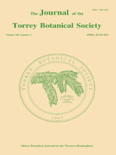
JOURNAL OF THE TORREY BOTANICAL SOCIETY
Unlocking the secrets of the natural world through botanical insights.JOURNAL OF THE TORREY BOTANICAL SOCIETY is a prominent academic journal dedicated to advancing the fields of botany and ecology, published by the esteemed TORREY BOTANICAL SOCIETY. With an ISSN of 1095-5674 and an E-ISSN of 1940-0616, this journal serves as a critical platform for researchers, professionals, and students to share their findings and insights. Despite its status in the Q4 category for the 2023 rankings across Ecology, Plant Science, and Ecology, Evolution, Behavior and Systematics, the journal continues to foster significant discourse and collaboration in the botanical sciences, aiming to elevate the understanding of plant biology and ecosystems. Its open access options enhance accessibility, ensuring that groundbreaking research reaches a wider audience. Published in the United States, the journal features work from both established scientists and emerging scholars, making it a vital resource for anyone involved in the study of plants and their environmental interactions. Explore the JOURNAL OF THE TORREY BOTANICAL SOCIETY to engage with cutting-edge research and contribute to the ongoing dialogue in the botanical sciences.

Brazilian Journal of Botany
Nurturing growth in botanical research and discovery.The Brazilian Journal of Botany, published by SOC BOTANICA SAO PAULO, stands as a vital resource in the field of plant sciences, particularly noted for its contributions to agricultural and biological research. With an ISSN of 0100-8404 and an E-ISSN of 1806-9959, this journal has established a robust presence since its inception, continuing to foster growth in botanical research through its anticipated publications from 2006 to 2024. Ranking in the second quartile (Q2) in Plant Science and positioned at 207 out of 516 within Scopus rankings, the journal demonstrates both quality and relevance, occupying the 59th percentile in its category. As an essential platform for scholars, practitioners, and students alike, it disseminates original research, reviews, and advancements within plant biology, thereby promoting understanding and innovation in plant sciences. While the journal currently does not offer open access, its rich content remains pivotal for those invested in the intricacies of botanical science.

PROCEEDINGS OF THE LINNEAN SOCIETY OF NEW SOUTH WALES
Connecting Research with Conservation in Australia's Unique EcosystemsPROCEEDINGS OF THE LINNEAN SOCIETY OF NEW SOUTH WALES, ISSN 0370-047X, is a prestigious journal published by the Linnean Society of New South Wales, dedicated to the advancement of knowledge in the fields of natural history, ecology, and biodiversity. Established in the mid-20th century, this journal serves as a vital platform for reporting original research, reviews, and discussions on various aspects of Australian flora and fauna, along with broader contributions to environmental science. Though the journal is not open access, it remains an important resource for researchers, students, and professionals seeking to engage with high-quality studies that inform conservation efforts and ecological understanding in the region. The journal's historical significance is underscored by its coverage of pivotal research from 1980 to 2015, fostering ongoing dialogue within the scientific community and promoting the values of the Linnean Society's commitment to natural history scholarship.

NEW ZEALAND JOURNAL OF BOTANY
Exploring the Depths of Plant Science and EcologyThe New Zealand Journal of Botany, published by the esteemed Taylor & Francis Ltd, serves as a pivotal platform for disseminating significant research in the fields of Ecology, Evolution, Behavior and Systematics, as well as Plant Science. With a rich history dating back to 1963 and an impressive convergence extending to 2024, this journal has established itself as an essential resource for researchers and professionals dedicated to understanding the complexities of plant life and ecological systems in New Zealand and beyond. The journal is currently categorized in the Q3 quartile for both relevant disciplines as of 2023, reflecting its balanced influence within the global academic community. Although not an open access journal, it retains a significant impact factor, evidenced by its Scopus rankings, which place it within the top half of its categories. This makes it an invaluable tool for students, researchers, and academics aiming to engage with robust, peer-reviewed scientific findings and contribute to the evolving discourse surrounding botany and ecological research.
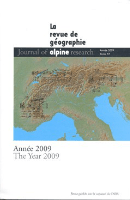
Revue de Geographie Alpine-Journal of Alpine Research
Pioneering Research for a Sustainable Alpine FutureRevue de Geographie Alpine-Journal of Alpine Research is a distinguished academic journal published by IGA-ASSOC DIFFUSION RECHERCHE ALPINE, focusing on the multifaceted disciplines of geography, environmental science, and alpine research. Since its inception in 1977, this peer-reviewed journal has established itself as a vital resource for scholars aiming to contribute to the understanding of Alpine environments, cultures, and issues related to sustainability. With an open-access model since 2007, the journal provides unrestricted access to its rich repository of research, enhancing visibility and global collaboration among researchers. The journal is indexed in Scopus and has been categorized in the Q4 quartile for both Earth-Surface Processes and Geography, Planning and Development as of 2023, positioning it as a relevant yet emerging platform within the academic community. The Revue de Geographie Alpine is committed to fostering dialogue and knowledge-sharing among researchers, professionals, and students dedicated to alpine studies, making it an essential contribution to the field.
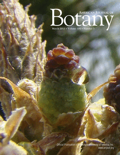
AMERICAN JOURNAL OF BOTANY
Pioneering Research in the World of PlantsAmerican Journal of Botany, an esteemed publication by Wiley, serves as a pivotal platform for the dissemination of groundbreaking research in the fields of botany, ecology, plant science, and genetics. With an illustrious history dating back to 1946, this journal holds a prestigious position in the academic community, evident through its Q1 ranking in both Ecology, Evolution, Behavior and Systematics and Plant Science, alongside a Q2 ranking in Genetics as of 2023. The journal maintains a competitive edge, ranked 159th in Ecology and Evolution and 124th in Plant Science according to Scopus metrics, underscoring its impact within the research landscape. Though traditionally not an open-access journal, it continues to provide valuable insights and advancements in botanical science, making it essential reading for researchers, professionals, and students dedicated to understanding and exploring the complexities of plant life. The journal's commitment to high-quality research ensures that it remains a cornerstone in the pursuit of knowledge in botany and related disciplines.

AUSTRALIAN JOURNAL OF BOTANY
Unveiling ecological interactions through rigorous research.The Australian Journal of Botany is a prestigious peer-reviewed journal published by CSIRO PUBLISHING, dedicated to advancing the field of plant sciences and ecology. Established in 1953, this journal provides a critical platform for researchers to share original research findings, reviews, and perspectives in subjects ranging from plant biology to ecological interactions, with a focus on Australian flora and its conservation. With an impressive impact factor and categorized in the Q3 quartile in both Ecology, Evolution, Behavior and Systematics and Plant Science, the journal ranks competitively within its fields, allowing authors to reach a diverse audience of professionals, students, and fellow researchers. The journal is accessible in print and electronically through its ISSN: 0067-1924 and E-ISSN: 1444-9862, providing wider access to vital research outcomes that influence environmental policies and natural resource management. As it aspires towards innovation and excellence, the Australian Journal of Botany remains an essential resource for those passionate about the richness of plant biodiversity and ecological understanding.
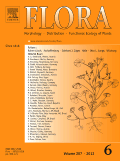
FLORA
Fostering Discovery in Ecology and EvolutionFLORA is a distinguished journal published by Elsevier GmbH, focusing on the realms of Ecology, Plant Science, and Evolutionary Biology. Established in 1975, this journal has been a vital platform for researchers and professionals, disseminating groundbreaking findings and insights relevant to the plant sciences. With an impressive impact factor and a current Scopus ranking placing it in the second quartile (Q2) across multiple categories, FLORA is recognized as a critical resource for advancing knowledge in its respective fields. The journal publishes both traditional research articles and significant review papers, ensuring a broad spectrum of academic engagement. Although not open access, FLORA remains committed to enhancing the scientific discourse and fostering collaboration among scholars worldwide. Researchers seeking to enrich their understanding of ecological dynamics and plant biology will find FLORA to be an essential addition to their academic repertoire.
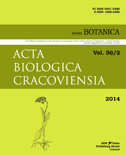
ACTA BIOLOGICA CRACOVIENSIA SERIES BOTANICA
Advancing plant science through rigorous research.ACTA BIOLOGICA CRACOVIENSIA SERIES BOTANICA is a distinguished journal published by the Polska Akademia Nauk (Polish Academy of Sciences), with its roots tracing back to 1996. As a pivotal publication in the field of Plant Science, it serves to disseminate high-quality research and findings, contributing to the ongoing development and understanding of biodiversity, plant ecology, and conservation. The journal is indexed under Scopus, ranked #203 out of 516 in its category, placing it in the 60th percentile and firmly within Q3 quartile for Plant Science in 2023. Researchers, professionals, and students will find invaluable content within its pages, enhancing their knowledge and supporting academic exploration. Although it currently does not offer open access options, the journal remains a crucial resource for those engaged in botanical sciences, with a commitment to advancing scholarship in Poland and beyond.